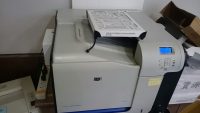The company noted its belief that laser printer OEMs “should integrate hardware-corrective measures to eliminate the release of nanoparticles during printing”.
The company invented and launched a filter for toner printers earlier this year, with the A4M1 model was unveiled after two years of testing. The filter, which fits to the printer, is capable of catching 92 percent of toner emissions, with the product patented and the company looking for distributors. Roger Teng, who used to work for TSICtec and GreenRich, told The Recycler that “recently, people are more concerned about the toner and VOC emissions from laser printers”, citing two research reports that outlined “toner emission could be the source of indoor air pollution”.
As a result, Teng developed the toner “catcher”, which he explained was a “filter on the top output bin of a printer”, with the product already granted a US patent. Teng said “there is more concern about air quality in work spaces and those in the laser printer manufacturing business need to take this seriously”, and according to TIME, an Australian study said that waiting at the printer is bad for your health, stating that “printers are just one of the many things we’re exposed to during the day that are potentially harmful”.
Teng has now discussed the contrasts between inkjet and laser printers in terms of emissions, noting that “according to IDC”, Epson “is now in the third place” in terms of market share, having introduced “new inkjet printers with supersized ink tanks and precision technologies which can produce high laser-quality, high speed and low-cost printing”.
Comparing the two types of printers, he noted that “inkjet printers don’t have ozone or toner emission (fine particles) issues”, and that HP Inc “follow[s] the same idea to develop new inkjet printers”, with both HP Inc and Epson promoting “their supersized ink tank inkjet printers and refillable cartridges aggressively in the global market”. He added that “not only laser printer manufacturers but also recyclers (both inkjet and laser) are facing a big challenge”.
He then referred back to the 2015 report by researchers at Harvard T.H. Chan School of Public Health’s Center for Nanotechnology and Nanotoxicology, which “assessed 11 common laser printers to see if they emitted nanoparticles during use, and whether these particles are harmful or not”. Because toners “aren’t listed in the presence of nanoparticles on the product labels, the first step was to confirm that they were indeed presented in formulations currently on the market”.
After tests proved positive, researchers “hit ‘print; and measured what came out”, with Teng noting that “results were surprising [as] they discovered that some printers release particles at concentrations comparable to highly-polluted highways”. He added that printer-emitted particles (PEPs) “caused significant” issues in terms of human health, including “cytotoxicity, membrane integrity damage, reactive oxygen species (ROS) production, pro-inflammatory cytokine release [and] angiogenesis”.
Other problems included “actin remodeling, gap cell junctions and epigenetic changes in cells at doses comparable to those from real-world exposure scenarios representative of inhalation exposures in the range of one to 200 hours”. Laser printer-emitted engineered nanoparticles, he stated, “can be deleterious to lung cells and may cause persistent genetic modifications that could translate to pulmonary disorders”.
PrinterAide developed the filter, he pointed out, as it can “effectively catch the fine particle emissions when they come out from the top output bin with paper simultaneously”, and he concluded by noting “we believe laser printer manufacturers should integrate hardware corrective measures to eliminate the release of nanoparticles during printings”.
You can contact Teng at taiwan@printeraide.com.tw.

